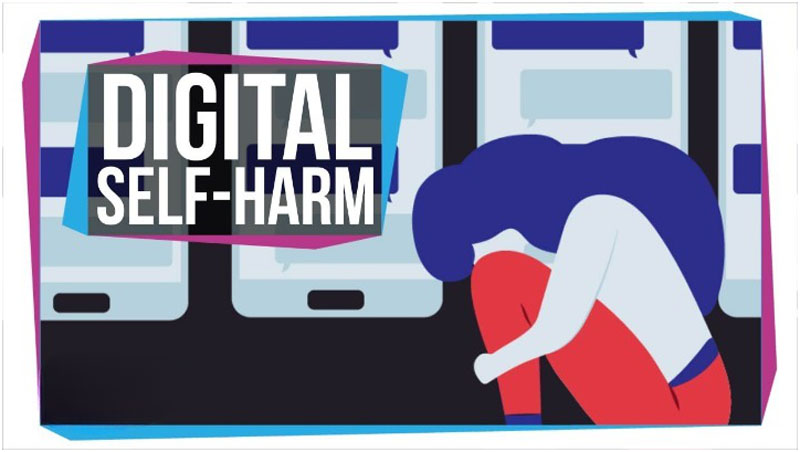Digital self-harm is a relatively new phenomenon that has emerged in recent years as a form of online self-harm. It involves an individual using social media or other digital platforms to send abusive or hurtful messages to themselves. This behavior can have significant consequences on an individual’s mental health and well-being, and may lead to the onset of mental disorders.
What is digital self-harm?
Digital self-harm, also known as self-trolling, is a form of online self-harm where an individual creates fake accounts or uses anonymous messaging apps to send abusive or hurtful messages to themselves. This behavior is often done to seek attention or sympathy from others, or as a form of self-punishment. In some cases, individuals engage in digital self-harm as a way to cope with emotional pain, anxiety, or depression.
Causes of digital self-harm
Digital self-harm is a complex phenomenon that can be caused by a variety of underlying factors. Here are some of the common causes of digital self-harm:
Attention seeking: Some individuals may engage in digital self-harm as a way to seek attention or sympathy from others. They may feel that they are not receiving enough attention or validation in their offline lives, and as a result, turn to social media or other online platforms to seek attention from others. By creating fake accounts or sending abusive messages to themselves, they may be able to elicit a response from others and feel validated or cared for.
Self-punishment: Some individuals may engage in digital self-harm as a form of self-punishment. They may feel that they deserve to be punished for something that they have done or for their perceived inadequacies or failures. By sending abusive messages to themselves, they may feel that they are taking responsibility for their actions or that they are somehow making up for their perceived mistakes or shortcomings.
Coping mechanism: In some cases, individuals may engage in digital self-harm as a way to cope with emotional pain, anxiety, or depression. They may feel overwhelmed by negative emotions or thoughts, and may use self-harm as a way to distract themselves or to release some of the emotional tension that they are experiencing. By sending abusive messages to themselves, they may feel a sense of release or catharsis, or they may be able to temporarily alleviate their negative emotions.
Cyberbullying: Some individuals may engage in digital self-harm as a result of cyberbullying. They may be experiencing harassment or abuse from others online, and may feel powerless or helpless to stop it. In some cases, they may turn the abuse on themselves as a way to take control of the situation or to make themselves feel as though they are the ones in charge. They may also be seeking attention or support from others in response to the cyberbullying.
Mental health issues: Digital self-harm can also be caused by underlying mental health issues such as depression, anxiety, or borderline personality disorder. Individuals who are struggling with these conditions may be more likely to engage in self-harming behaviors, whether online or offline. They may be experiencing negative emotions or thoughts that they are unable to manage effectively, and may turn to self-harm as a coping mechanism.
In summary, digital self-harm can be caused by a range of underlying factors, including attention-seeking, self-punishment, coping mechanisms, cyberbullying, and mental health issues. By understanding these causes and addressing the underlying issues that contribute to digital self-harm, individuals can work towards developing healthier coping mechanisms and reducing their risk of engaging in self-harming behaviors.
Impact on an individual’s mental health
Digital self-harm can have a significant impact on an individual’s mental health and well-being. Research has shown that it can lead to increased feelings of anxiety, depression, and low self-esteem. It can also contribute to feelings of social isolation and loneliness. Additionally, individuals who engage in digital self-harm may be at a higher risk of developing mental disorders such as borderline personality disorder, depression, and anxiety disorders.
Does digital self-harm lead to the onset of mental disorders?
While digital self-harm may not directly lead to the onset of mental disorders, it can contribute to the development of these conditions. Individuals who engage in digital self-harm may be at a higher risk of developing mental disorders such as borderline personality disorder, depression, and anxiety disorders. However, it is important to note that the development of mental disorders is a complex process that involves many factors, and digital self-harm is just one potential contributing factor.
How to reduce digital self-harm with the help of online counseling
Online counseling can be a helpful resource for individuals who engage in digital self-harm. Counsellors can provide support and guidance to help individuals develop healthier coping mechanisms and strategies for managing negative emotions. They can also help individuals identify underlying issues that may be contributing to their digital self-harm and work with them to address these issues.
Seeking support from friends and family members who can provide emotional support and encouragement.
Use the TalktoAngel messaging service to get in touch with the ideal therapist. additionally, “well “therapist near me” or relationship counsellor.
Conclusion
Digital self-harm is a concerning phenomenon that can have significant consequences on an individual’s mental health and well-being. It is important for individuals who engage in this behavior to seek support from mental health professionals and to develop healthier coping mechanisms and strategies for managing negative emotions. Online counseling can be a helpful resource in this regard.
